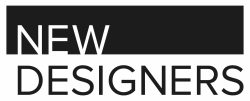COLOUR TO AID THE USER THROUGH VISUAL COGNITION & RECOGNITION WITH ESME WHEATLEY
This month’s theme explores Colour In Design, calling on emerging talent to question the importance of colour, provide insight into their design process and discover why it is paramount to that particular designer’s practice.
We also look to industry professionals to shine a light on this topic, collecting expert advice and guidance for the next wave of designers and those interested in how brands align or consider the significance of colour in design.
Discover below why 2020 is a deep, dark purple for this designer and how Esme channels the colours which surround her everyday for inspiration.

Colour In Design means freedom of expression and celebration of colour and all its glory. I think that colour is often overlooked and undervalued. It is usually something that we undermine or brush off as implicit. Colour In Design enables one to see how we can take colour to the next level and demonstrate that the possibilities of colour are endless.
Do you believe colour can be a communicator and if so, what are your colour theories?
Absolutely, I believe that colour’s purpose isn’t purely surface aesthetic. Colour can provoke an emotion as a by-product and encourage engagement. Or a colour can consciously or subconsciously change consumer behaviour in a given environment.
I believe that the value and purpose of colour within a designed object helps push boundaries and broadens our thinking and perspective. Colour isn’t a standalone factor, it links with everything we do in our day to day lives. I don’t have one specific colour theory, I guess I live by the rule that colour makes everything better.
Is colour timeless or does it evolve? Can you give us an example of a trend or colour patterns you have experienced?
That’s a tough one.
I would say that colour is timeless but does evolve in terms of patterns, combinations and trends. I think that we often find ourselves going back to colour combinations and patterns of the past from burnt oranges, yellows and neutral browns of the 60’s to the burst of bright rainbow colours of the 80’s. I’m often drawn to shades of orange, green, pink and red and this is definitely reflected in my wardrobe. I never wear all black or neutral tones alone, I always have to have a pop of colour and feel this is echoed in my work.
Where do you find your colour inspiration?
I find colour inspiration all around me, but currently I get a lot of inspiration from food (due to my current job) and just observing what I see day to day as I travel around London. I’ve grown up in a very creative household with lots of eclectic art forms. I found myself at various stages during lockdown revisiting various books and finding colour and pattern inspiration.
Do you follow any colour design rules? Can you share any no-goes on colour matching or any winning colour harmonies you have created?

I came across Dieter Rams colour beliefs during my final year of university and it’s stuck with me since. He believed that colour should ‘fit the product’ and didn’t want it to be a distraction from the function of the object but as a means of communication in measured ways, proven in his designs, green button for ‘on/off’ or red for ‘fm’ on calculators or radios. He often used colour to aid the user through visual cognition and recognition.
Recently for work, a winning colour harmony I created was photographing a dark green and warm yellow courgette against a rich baby-blue background. This combination made the colours really optically vibrant, almost hallucinogenic.
What have you been working on over this past year? What lies ahead for you, can you share a sneak peek of your upcoming projects?

I intend to advance the research which I began in my dissertation ‘Colour and Purpose: To Understand the Relationship Between Colour and the Designed Object’. My thesis will be explored by applying its precepts to food photography (@lmdcuk) thus creating a new colour palette.
Additionally, I aim to develop Colour Purpose, a creative tool, ideally modelled as an app which helps designers to think outside the box. It puts colour first in the design process. The tool provides a brief generator using colour as its primary driver. I’m hoping this places me in a strong position for employment in the trend forecasting sector.
If 2020 was a colour, what would it be for you and why?
That’s a tricky one, 2020 has been such an unprecedented year with many people experiencing a roller-coaster of emotions. Now that we’re hopefully coming out of the pandemic I feel there is a sense of eagerness to go back to normality. However, I also think that there is a great sense of underlying anxiety and uncertainty amongst individuals.
If I had to give 2020 a colour, it would be a very deep, dark purple almost grey, evoking an ominous feeling the longer you look at it.




